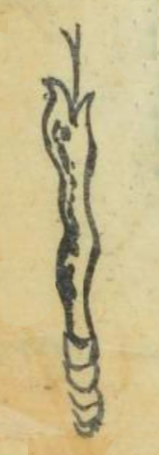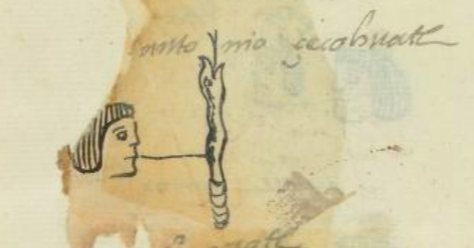Ce Coatl (MH521v)
This black-line drawing of the simplex glyph (plus notation) for the personal name Ce Coatl (here, attested as a man's name) builds the notation for one (ce) into the simplex glyph for serpent (coatl) by showing the serpent completely vertical and straight, reminiscent of some ways of showing the number one (see below). This serpent has an open mouth, a protruding, bifurcated tongue, and a segmented rattle. Its head is at the top, tail at the bottom. It has some vague patterning on its back and a white belly.
Stephanie Wood
This name comes from the tonalpohualli, the 260-day divinatory calendar. Calendrics were an important element in the Nahuas' religious views of the cosmos.
The Templo Mayor (Great Temple) of the Aztec capital city had offerings of the remains of what had been live rattlesnakes of various species (e.g. Crotalus molossus, Crotalus triseriatus, Crotalus ravus, Crotalus atrox, Crotalus polystictus, and Crotalus durissus), but also artistic representations of these snakes, according to signage at the museum. (2/15/2023)
Stephanie Wood
antonio çecohuatl
Antonio Ce Coatl
Stephanie Wood
1560
Stephanie Wood, José Aguayo-Barragán
numbers, números, ones, unos, cohuatl, serpents, serpientes, nombres de hombres
This autonomous-era stone carving of a rattlesnake is from the Templo Mayor. Photo by Robert Haskett, 2/15/2023.

ce, one, https://nahuatl.wired-humanities.org/content/ce
coa(tl), snake or serpent, https://nahuatl.wired-humanities.org/content/coatl
Uno-Serpiente o 1-Serpiente
Matrícula de Huexotzinco, folio 521v, World Digital Library. https://www.loc.gov/resource/gdcwdl.wdl_15282/?sp=122&st=image
This manuscript is hosted by the Library of Congress and the World Digital Library; used here with the Creative Commons, “Attribution-NonCommercial-ShareAlike 3.0 License” (CC-BY-NC-SAq 3.0).



